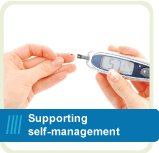Supporting Self-management
Key Message


Around two million people, 40 per cent of the Scottish population, have at least one long term condition, and one in four adults over 16 report some form of long term illness, health problem or disability ( Scottish Government 2015).
Living with a long term condition involves three different kinds of tasks: care of the body and understanding and following complex medical regimes, adapting everyday activities and making changes to lifestyle, and dealing with the emotions arising from having the condition. (Source: Institute for Healthcare Improvement)
Self-management focuses on helping people help themselves to become active managers of their own health. It encourages people living with long term conditions to access information and to develop skills to manage their condition. This enables well informed decisions about their life and the realisation of their own personal goals.
There are a number of core elements to effectively support self-management including:
- Building supportive and collaborative relationships that help people to gain confidence and motivation to make changes to their lives.
- Developing partnerships to support care and shared decision making and working with others such as the voluntary sector.
- Adopting a risk enablement approaches in order to maximise a person's independence.
- Taking a strengths-based approach by valuing the whole person and capitalising on their talents, resources and connections, in other words their strengths and not their deficits.
What does this mean for the Effective Practitioner?
Effectively supporting self-management depends on practitioners taking a collaborative, person-centred approach that requires a cultural shift from the model of 'fixer' to 'enabler'. it is not 'doing to' but 'doing with' with the individual as the leading partner in managing their own life and condition(s).
The focus is on the person, their values, beliefs and experience and not on the condition. There should be a strong emphasis on health coaching. A person's willingness to engage in self-management can be affected by the quality of the relationship with the care provider therefore good communication skills are essential for effective and sustained self-management.
![]() You can download a copy of
the Supporting
self-management learning activities.
You can download a copy of
the Supporting
self-management learning activities.
Reflection
Remember, recording your reflections is an important part of the learning process. Take time to structure your thoughts, feelings and any future actions on one the forms available in the Reflective Practice section. Click here to visit the page.
In your reflections you could also consider how your learning relates to the Facilitation of Learning, Leadership and Evidence, Research and Development pillars of practice.
Return to top
